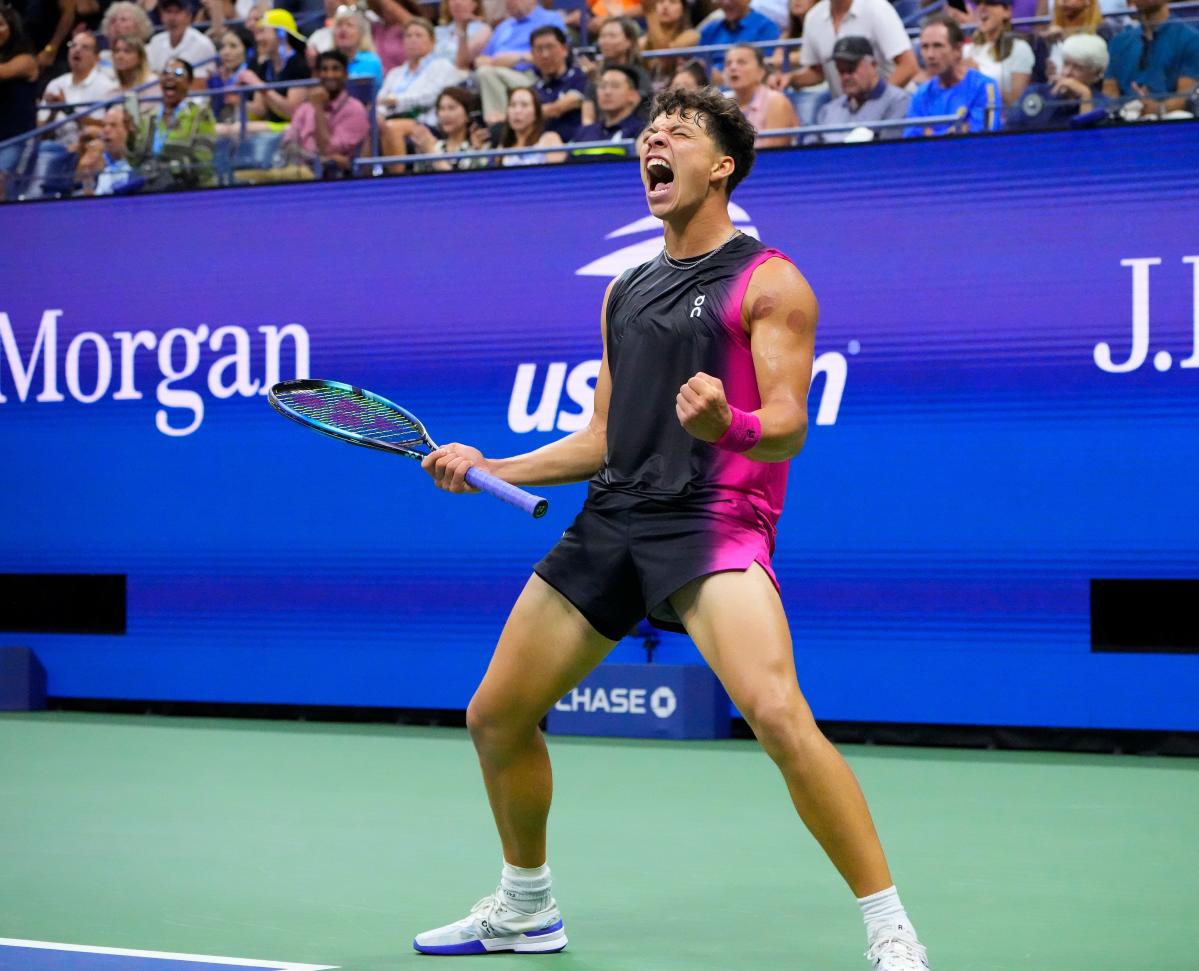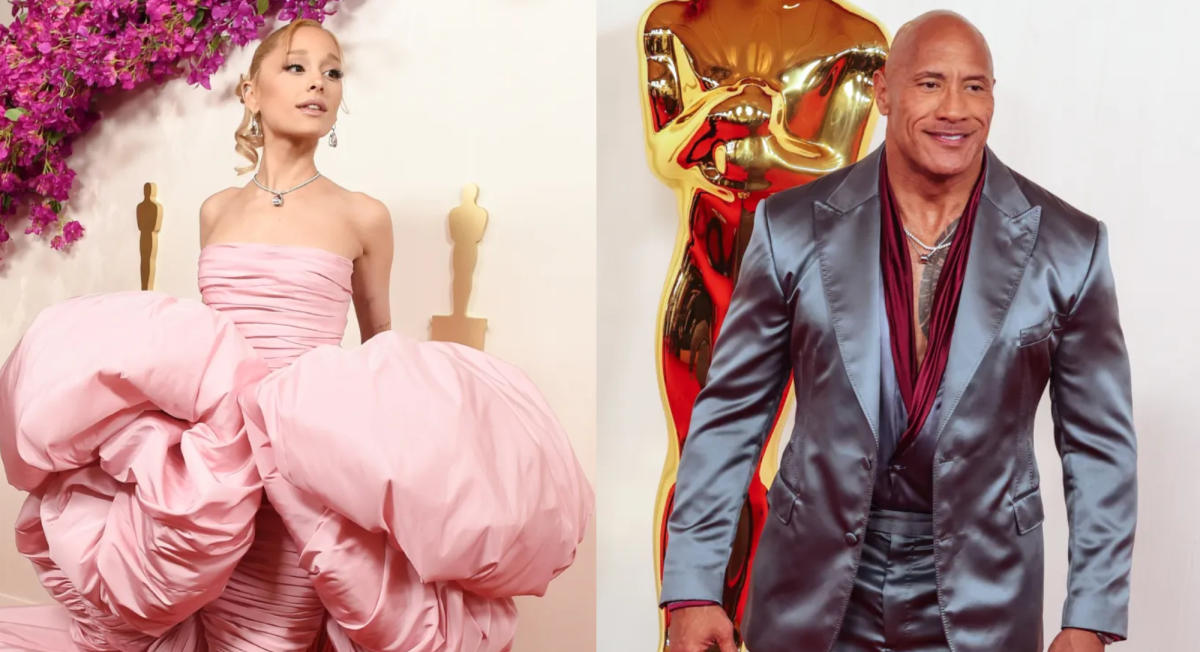NEW YORK — Men’s tennis is on the verge of something interesting, and Ben Shelton is going to be part of it for a long time.
You can feel it all over the grounds at the Billie Jean King National Tennis Center during the US Open, just like you could this year at Wimbledon when another 20-year-old sensation named Carlos Alcaraz beat Novak Djokovic and took home his second Grand Slam title.
It is a different energy than what fans became used to when Roger Federer and Rafael Nadal ruled the sport. Call it tennis for the TikTok generation, with highlights that look like NBA fast breaks, celebrations straight out of WWE and athleticism that is going to push this sport to places it has never been before.
Unlike Alcaraz, Shelton could not take down the legend in the US Open semifinals. Djokovic won by a comfortable scoreline — 6-3, 6-2, 7-6 (7-4) — but it was not a comfortable afternoon for the man who will play for his record-tying 24th Grand Slam title on Sunday.
DJOKOVIC: Steals Shelton’s phone celebration after beating 20-year-old at US Open
You could tell by the hangdog body language Djokovic carried around the court in the third set as Shelton, unlike many of the other young Americans who have faced a similar situation, refused to pay deference by bowing out meekly. Instead, Shelton kept firing away, breaking Djokovic twice to get into a tiebreaker and mean-mugging after some of his winners like he was in the lead rather than two sets down.
Djokovic clearly didn’t appreciate it. After match point, he mimicked Shelton’s “Call me” celebration, strode to the net and offered a much colder handshake than you normally see.
“I think if you win the match, you deserve to do whatever you want,” Shelton said. “As a kid growing up, I always learned that imitation is the sincerest form of flattery, so that’s all I have to say about that.”
The kid from the University of Florida wasn’t ready to win this kind of match. But in terms of getting under Djokovic’s skin? He already might be top five in the world.

As it stands, Shelton exits the US Open as a star with a real chance of breaking through the normal boundaries of tennis fandom. It’s been 20 years since an American man has won a Grand Slam — Andy Roddick at the 2003 US Open — and his run to the semifinals here in his first full year as a professional suggests he might be the one to eventually break the drought.
But now that Shelton has established that he has the game to make this kind of run at a Grand Slam, he needs to spend the next year between now and the next US Open doing something that has eluded him so far.
He needs to start winning when the lights aren’t this bright.
Shelton will leave the US Open ranked No. 19 in the world, but the remarkable thing is that nearly all of his equity has come through two tournaments: This one and the Australian Open in January, where he took advantage of a soft draw and made a quarterfinal run.
Nobody should take anything away from what he did in Australia; winning four matches was a remarkable performance for someone who had never even been outside the country. But when Shelton spent the next seven months struggling to back it up in regular ATP Tour events, the result in Australia started to look like an outlier.
Nobody can say that about what Shelton did at the US Open.
WOMEN’S FINAL: Coco Gauff faces new No. 1 in powerful, complicated Aryna Sabalenka
He played an excellent set against former champion Dominic Thiem in the second round before Thiem retired with an illness. In the third round, he imposed his will on Aslan Karatsev, an imposing physical specimen. In the fourth round, he easily handled American Tommy Paul, who had been one of the best players of the summer hard court swing including a win over Alcaraz. And in the quarterfinals, he was significantly better than another American, Frances Tiafoe, who is now planted in the top-10 with a lot more reps than Shelton in those kinds of matches.
It was a legitimate run. And even against Djokovic, Shelton showed that he has the weapons to hurt the best of the best, albeit with a lot of raw edges still when it comes to shot selection and efficiency in the forecourt.
“If anything, this week has just motivated me more,” he said. “I feel like last time I had a big run in Australia, I got fairly complacent after it happened and thought I’d really done something or go to some place and had a tough couple months after that.”
It should be all up from here, but tennis doesn’t always work that way. As great as it is that Shelton can say he’s a US Open semifinalist before his 21st birthday, it’s fairly jarring to realize it’s his first semifinal at any ATP-level tournament.
When Shelton gave up playing quarterback and committed to being a tennis player in middle school, his father and coach Bryan Shelton — himself a former tour pro — was adamant about not skipping steps. Unlike a lot of his peers, the Sheltons valued social development and going to regular high school rather than traveling all over the world to chase ranking points in the big junior events.
“I always have the inside-out approach,” Bryan Shelton said. “If you can dominate in your inner circle, then you can move out a little bit further one step at a time.”
In some ways, it feels like Ben Shelton has skipped some steps in his first year on tour. A quarterfinal in his second Grand Slam, a semifinal in his fifth. A high-profile apparel and shoe deal with On, the company that Roger Federer made an early investment in. A top-20 ranking without ever winning an ATP tournament or even playing in a final.
That lack of résumé might explain why it bothered Djokovic to see this ball of energy shouting and fist pumping and trying to fire up the crowd at every opportunity. But for those of us with long memories, it was similar to how a teenage Djokovic annoyed his elders with antics and imitations of their service motions and routines.
But those qualities — if Shelton can back them up with consistent results — are going to help make tennis cool again. It may never be like the 1980s when Jimmy Connors was appearing in Super Bowl commercials, but players like Shelton and Alcaraz have the potential to reach beyond an audience that knows the difference between gut and polyester strings.
That has been said before about players like Tiafoe or Nick Kyrgios, but the cold reality is that none of them have been consistent enough — or really good enough — to be reliably relevant from Grand Slam to Grand Slam, much less week to week out on tour.
We know Alcaraz is different. He’s literally changing the game, the evidence for which you can find at any tennis club or junior tournament these days in how many players of all levels are trying to copy his drop shot — a play that was almost out of style until he revived it.
With the way he flies around the court, deploys his considerable power and crafts points with thoughtfulness and touch, every point feels like it could end up on a YouTube highlight package.
He is essentially tennis’ answer to Steph Curry, bending the geometry of the court and playing with an audacity that we’ve never quite seen before. And when he won the Wimbledon final, it seemed like he broke through from tennis player to global star entertainer.
“Obviously want to win every match that I play, but at the same time, I want to have fun, trying different things, make the people enjoy watching tennis, watching my matches,” Alcaraz said. “Sometimes I talk to myself about what is most important: If I win or doing (exciting) things. Obviously win the matches is always most important. But sometimes I talk about that.”
As the 36-year-old Djokovic fades — as he inevitably will over the next couple years — Alcaraz won’t be able to carry tennis alone. He will need rivals, and he will need others who share his thirst to entertain and engage.
Shelton has that part down already. If he can reliably replicate what he found over these two weeks in New York, he will have a starring role in bringing this sport back to the mainstream.
This article originally appeared on USA TODAY: Ben Shelton serves up star power in US Open loss to Novak Djokovic







